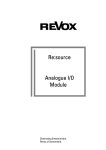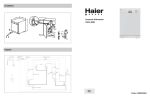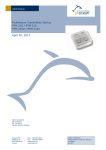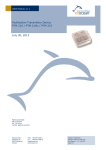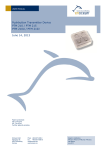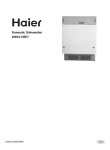Download Revox M301 Technical data
Transcript
of t of and Re:connect M300 / M301 Video switch Dominating Entertainment. Revox of Switzerland. M300/ M301 Re:connect Contents Video switch Installation M300 - SCART M301 – RCA plug 2 2 3 3 Video switch principle Connection options Connection format Format ⇔ Quality Video format 4 5 6 7 7 Monitor connection panel SCART output features Parallel operation 8 8 8 Video switch operation Selecting the video source Selecting the recording source Free selection of listening source Modifying source names Edit function Restoring standard names 9 9 9 10 10 11 13 Technical data Guarantee 14 14 1 M300/ M301 Re:connect Video switch Installation In order to be able to work comfortably with the wealth of multimedia devices that are available, the video and audio signals need to be controlled intelligently. The M300 and M301 Video switch from REVOX offers you this comfort in some impressive ways. It can receive many different video and audio signals and then transmits them on to the correct devices. But it doesn’t just distribute these signals, it also processes them, using some incredibly clean and powerful audio and video drivers. There are two versions of the video switch, which are differentiated from each other by the connector panel that connects the video switch with the M51. M300 The M300 has a single SCART connector that handles the complete communication with the M51, including the video and audio signals. Correspondingly, you need the DVD MKII module with the SCART Connector (Part no.: 1.551.083.02) for the M300. These high quality drivers are even able to process the highresolution video format HDTV. M301 The video switch is controlled through the M51. The M301 outputs the audio and video signals through individual RCA plugs. Additionally, a patch cable (a screened and uncrossed RJ45 cable) is needed for the control functions. Correspondingly, you need the DVD MKII module with the RCA connectors (Part no.: 1.551.083.03) for the M301. 2 M300/ M301 Re:connect M300 SCART version M301 RCA plug version The M300 is connected to the M51 DVD MKII module using a fully switched, 21-pin SCART cable as shown in the figure below. The SCART cable delivered with the M51 fulfils these requirements perfectly. You will need two RCA stereo pairs for the video signals and two RCA stereo pairs for the audio signals to connect the M301 with the M51 DVD RCA module. Additionally, the M301 and the M51 are connected with a patch cable (a screened and uncrossed RJ45 cable) for the control functions. Important The M300 only works together with the DVD MKII Module (Part no.: 1.551.083.02). The DVD MKII module is easy to recognise as it has an optical digital output, as opposed to the MKI module that has a coaxial digital output. The complete cabling locks like the following: In order not to reduce the picture and sound quality, the complete cable length (M51M301 + M301-Monitor) should not exceed 10 m. In order not to reduce the picture and sound quality, the complete cable length (M51M300 + M300-Monitor) should not exceed 10 m. 3 M300/ M301 Re:connect Video switch principle Essentially, the M300/ M301 video switch is a set of external connections where different video output and different recording devices can be connected. Connecting a video switch adds an additional 6 video sources (Video 1...6) to the M51 Source menu. These additional video sources appear automatically in the M51 Source menu. If you want to be able to call them with the remote control, the Remote menu must be modified (see the Remote section in the Introduction chapter). Additionally; you have the option of recording audio and video signals with the video sources 1 and 2 (shown below by the arrows), e.g. using a video recorder or video server. The M51 then takes over the complete control of the video switch. The figure below shows how the different audio and video signals find their way to the individual devices. Video switch basic function 4 M300/ M301 Re:connect Connection options The figure below gives you an overview of the connection options that the M300 and/ or M301 offer. In order to make this possible, there must either be a SCART connection to the television or the TV audio output must be connected to the Audio IN on the monitor field on the M300/M301 with a stereo RCA cable. The audio signal from the video sources attached is transmitted by the M51 whereas the picture signal is handled by the video devices attached, such as TV, video projector, etc. All other connections are made as shown. Additionally, the sound from the TV can be put through the M51. 5 M300/ M301 Re:connect Connection formats In detail, the following connections can be made with the video sources 1 - 6: Connection Video 1 Video 2 Video 3 Video 4 Video 5 Video 6 Monitor L YC CVBS RGB Y Cr Cb = = = = Video Format Input Output YC YC CVBS CVBS YC YC CVBS CVBS YC CVBS YC CVBS YC CVBS RGB YCrCb YC CVBS RGB YCrCb YC CVBS RGB YCrCb SCART Audio Format Input Output Analogue stereo Analogue stereo Analogue stereo Analogue stereo Analogue stereo Analogue stereo Analogue stereo Digital stereo Digital 5.1 (Coaxial) Analogue stereo Digital stereo Digital 5.1 (Optical) Analogue stereo Analogue stereo S-VHS Signal Normal video signal , also known as FBAS Component signal with Red, Green, Blue Colour difference signal, also shown with Y PR PB You will find a more detailed description in the section Video mode in the chapter DVD MKII-Module. 6 M300/ M301 Re:connect Format ⇔ Quality Video format The quality of the picture reproduction depends to a large extent on the video format you use. Using the video switch, you connect different video formats to the inputs as well as the monitor output. The more parameters that affect the picture, such as brightness, colour and contrast, that are grouped together, the worse the quality of the picture will be. On the other hand therefore, the more parameters that can be set individually, the better the quality. As we are dealing with a video switch here, the video signals are output in the same format as they are fed in. Example: An RGB signal fed into the Video 5 input will also be output as an RGB signal to the monitor output. The following list gives you an overview on this topic: No conversion (Up- or DownMix) from one video format to another video format is carried out. A Very good picture quality RGB / YCrCb 3 component signal YC Æ CVBS conversion One exception to this is the YC signal. This is the only signal that is converted to the CVBS format. In this way, it is possible to feed in a YC signal through the M51 or one of the six video inputs (S-VHS) but to operate a CVBS device at the monitor output panel. Additionally, this CVBS signal is also available at the Video 1 and Video 2 outputs. B Good picture quality YC (S-VHS) 2 component signal C Acceptable quality CVBS (FBAS) 1 component signal Important It doesn’t improve the quality of the picture if a YC or even an RGB signal is artificially created out of a CVBS signal. This doesn’t increase the amount of picture information, it simply copies it. 7 M300/ M301 Re:connect Monitor connection panel SCART output features The monitor connection panel is set out the same for the M300 and the M301 versions of the video switch. If your device is fitted with a SCART input, this is the recommended connection to use as you can also output a 6/12 voltage through the SCART connector. This switching voltage automatically switches on the TV device with the correct input, once an RGB signal is present from the M51 or the Video 5 or Video 6 sources. A pre-quirement for this is that Video mode has been set to RGB+CVBS through the DVD MKII module set-up. This switching voltage is part of the SCART standard and for this reason, it doesn’t work with the YC or YCrCb signals. This is where you connect the devices that reproduce the picture. This can be an LCD or plasma screen or a normal television. Further, these outputs are also available with projectors and beamers of course. Parallel operation Internally, and at the monitor panel, the video switch uses exceptionally clean and powerful video amplifiers. This means that several monitors can be operated in parallel at different outputs without impacting on the quality of the picture. In this way for example, the television can be connected through SCART while the projector can be fed with a signal from the YCrCb output. The television sound from the TV source can be put through the M51 using the Audio-IN socket. With a SCART connection, these audio signals are already integrated. 8 M300/ M301 Re:connect Video switch operation Selecting the recording source Selecting the video source The different sources are selected through the SOURCE menu. Press the Source button on the M51 and the following menu appears: If you want to make a recording using a device such as a video recorder, for example, the M51 needs to know which source is to be recorded from. To do this, select the source as described previously in the Selecting the video source chapter and then press the Record softkey. Now you can select the individual Video and/or TV sources by pressing the corresponding softkey. Video 1 has been selected in the above display as shown by the text: Listening: Video-1 Now, the music signal from the selected source (e.g. Video-2, DVD/CD, Aux2, etc.) will be sent to the recording device connected to the REC-OUT RCA connector. If the required source is not shown on the first SOURCE page, simply scroll to the next page by pressing the More softkey. This will be shown in the display by: Recording: Video-1 9 M300/ M301 Re:connect Modifying source names Free selection of the listening source while recording The video switch offers you the option of selecting your own names for the inputs. You no longer have to remember which external device is connected to which input. You can assign names that tell you immediately what is connected where. The M51 also offers you the option of listening to one source at the same time as you record another. You could for example, be recording a television programme on a video server through Video-1, while watching a DVD at the same time. You can enter a maximum of 8 characters as name text. Select the video source whose name you want to change through the SOURCE menu. This is possible with: Video 1 to Video 6 and TV To select a different source to listen than the one you are recording, simply select the listening source through the SOURCE menu, once you have selected the recording source with the Record softkey, as described in the Selecting the recording source chapter. You call up this function by pressing the Setup key for about 2 seconds and then pressing the Source softkey. The following display appears: Example: In the above example, the display shows that you are listening to a DVD/CD while making a recording through Video-4. 10 M300/ M301 Re:connect Edit function The following name changing options are available: The Å Cursor softkey moves the [ ] cursor to the left Please note The CursorÆ moves the [ ] cursor to the right Whenever you can change a setting using the rotary control knob in the next section, the area to be modified appears in the display between two square brackets [...]. At the same time, the small red Jog light next to the knob on the M51 lights up. The Delete softkey deletes the character at the position where the [ ] cursor is currently located. The Insert softkey inserts a character to the left of the [ ] cursor. The manual highlights this additionally in the individual sections, with the following symbol: The Store softkey saves the currently displayed name and returns you to the Source menu. The Cancel softkey returns you to the main source menu without saving the changes made. ½[ ] 11 M300/ M301 Edit characters Re:connect Once the required source name has been selected in this way, it can be saved with the Store softkey. ½[ ] The actual modification of the individual characters (letters and digits) is done through the rotary control knob. When you turn the knob, upper case letters appear in alphabetical order, followed by lower case and then the digits from 0 - 9. This order can be reversed by turning the knob in the opposite direction. If you want to exit without saving, press the Cancel softkey. Example In the following example, the input Video-1 was given the name Satellit. Character order: ... _ A B ... ... X Y Z ... ... a b c ... ... x y z ... ... 0 1 2 ... ... 9 - . ... 12 M300/ M301 Re:connect Restoring standard names You are then returned to the Setup menu. If you want to change a modified source name back to the factory setting, select the corresponding video source from the SOURCE menu. The standard name is now restored. In our example, this would be Video-1. This is possible with: Video 1 to Video 6 and TV You call up this function by pressing the Setup key for about 2 seconds and then pressing the Source softkey. Now press the Edit Name softkey to go to the editing menu. The standard name is restored by deleting the modified name completely with the Delete softkey as shown below. When you now pres the Store softkey, the factory setting name is restored. 13 M300/ M301 Re:connect Technical data Video data Video bandwidth Distortion factor SN ratio Up to 10 MHz/ ± 3dB < 0.1% > 60 dB (HDTV enabled) (Typically .5 MHz) Replay formats: S-VHS CVBS RGB YCrCb Systems PAL NTSC Audio data Audio bandwidth Noise voltage spacing Channel separation Distortion factor (THD) Signal amplification 20 Hz - 20 kHz/ ± 1dB > 100 dB (Typically 1 Vpp) > 70 dB < 0.02% 1 Dimensions: 15.35 x 4.15 x 1.58 in. 390 x 105 x 40 mm Errors excepted. Product subject to modification Description: Version 0.92 (Controller software DVD-MKII) Guarantee carriage free and without any accessories, to your national Sales Office. Please supply a complete description of the problem and a full return postal address. The guarantee period is 24 months from the date of purchase. Your dealer should be your first contact if you need service. If he can't give you the help you need, send your Video switch, M300-/ M301-Video switch operating instructions/ Part no.: 10.30.3051 14















